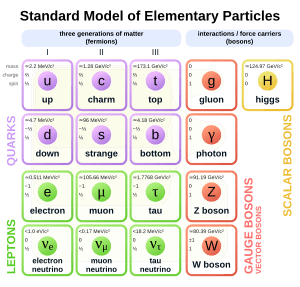Gauge boson facts for kids
Gauge bosons are tiny particles that act like messengers. They carry the energy and information that create three of the four main forces in the universe. Think of them as the delivery people for forces!
In the world of particle physics, which studies the smallest parts of matter, there are four types of these messenger particles.
- W and Z bosons: These particles carry the weak force. This force is important for things like radioactivity and how the Sun produces energy.
- Gluons: These carry the strong force. This is the strongest force, holding together the tiny particles inside the center of an atom.
- Photons: These carry the electromagnetic force. This force is responsible for light, electricity, and magnetism. It's why magnets stick to your fridge!
There's one main force left that doesn't have a known gauge boson: gravity. Scientists believe there might be a special particle for gravity called a graviton, but they haven't found it yet.
What Makes Them Special?
All gauge bosons are a type of particle called a boson. This means that many of them can be in the same place at the same time. Imagine a crowd of people – bosons can all stand on the same spot! This is different from other particles called fermions, which need their own space.
Bosons also have a special property called spin, which is like an internal rotation. For gauge bosons, this spin can be 0, 1, or 2.
Why Do Some Have Mass?
Scientists believe that gauge bosons interact with something called the Higgs field. This invisible field is thought to be why some gauge bosons, like the W and Z bosons, have mass (meaning they have weight), while others, like photons, do not. It's like walking through thick mud (Higgs field) – some particles get slowed down and gain "weight," while others pass right through.
See also
 In Spanish: Bosón de gauge para niños
In Spanish: Bosón de gauge para niños


